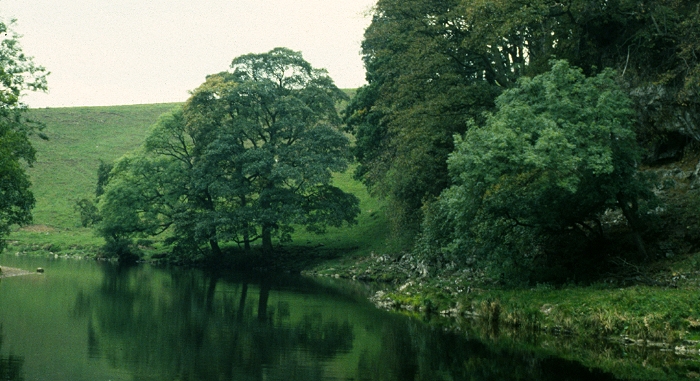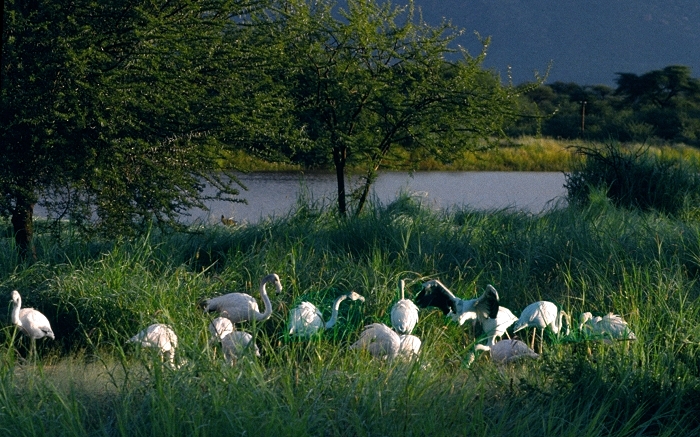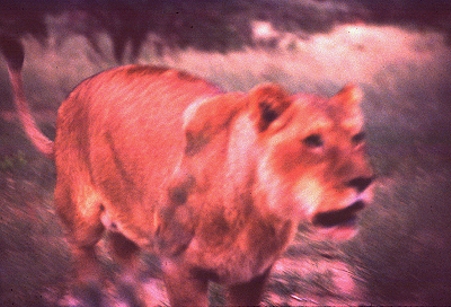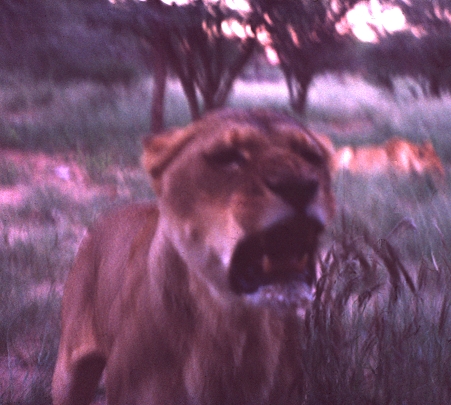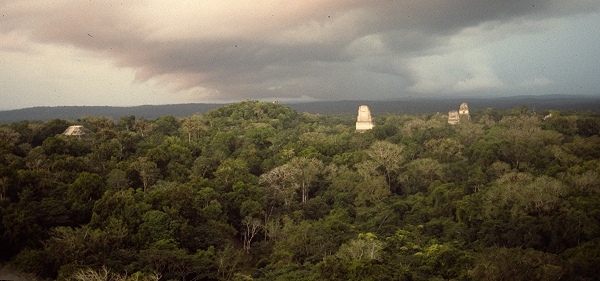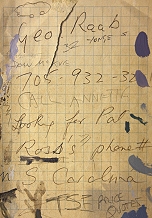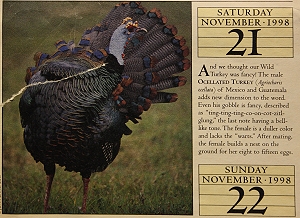| Currently Gallery Original Prints Books Bio Contact Home |
 |
 Symmetries |
||||||||||
Along the bank of the river Wharfe, on a rainy, overcast day in North Yorkshire, I was mesmerized by the patterns that disturbed the water's quiet surface. As raindrops filtered through the foliage overhead and splashed into the water, concentric rings radiated outward, intermingling and dissolving back into the stillness from which they emerged. Ripples dancing on the dark surface describe a phenomenon that is characteristic of all forms of energy. The “interference patterns” generated – seen here in a most rudimentary form – describe the underlying nature of the reality we perceive. From the “standing waves” that give spiral galaxies their appearance to the dynamic by which energy itself exists in the form of matter. To use this analogy, ripples in the flat, two-dimensional surface of water are a manifestation of the energy contained within, which intrudes upon three-dimensional space. Likewise, elementary particles are projections into our world of an underlying energy field. As interference patterns fixed in a thin piece of film or glass result in a holographic image, giving the impression of tangible form and physical depth, taken to another level, this same phenomenon describes a holographic model of the universe, where physical form is one aspect of a dynamic that exists largely outside the world we see. One of my clearest childhood memories is of being in a dusty old museum near the town of Bradford, in England, and being completely enthralled by the swirling colours that resulted from a hands-on demonstration of 'thin-film interference.' The strange apparatus was like something from "The Cabinet of Dr. Caligari." A lever with a Bakelite knob allowed one to apply pressure in different areas of a glass screen, and patterns of swirling colour shimmered across the surface, like those on a bubble of soap. This wonderful apparatus, contained, in typical Victorian fashion, within a drab, black box, was like magic. It was a window into the mysteries of the world and, from that day on, I have been unable see art as something separate from science. Interference patterns, harmonics, and symmetries define the reality we know, and this idea of patterns hidden within resonates with my own observations as an artist.
Return to main page |
|||||||||||
 |
 After the Rain |
||||||||||
Set in the semi-desert of Namibia (Southwest Africa), between the Namib and Kalahari deserts, to date, this is the only rainbow I have painted. Typically, an artist would avoid such overly "picturesque" compositions, for fear of being regarded as a painter of kitsch. Painting any subject that might be considered "beautiful" is to risk entering the world of decorator art. “Serious art” today (we are told) is all about concept over content – though it must be said that most conceptual art seems to fall short of the mark, even by its own measure. I feel strongly that an artists should never, in any way, be limited, and particularly by the dictates of an art establishment. Though I will admit, on those rare occasions when I have been tempted to paint something as cliché as sunset or – in this case – a rainbow, a little voice in the back of my mind always asks, what else am I trying to say? The 'sofa size' sunset will always sell, of course, as decor – something reasonably priced, usually by the square foot, in colours that accent the carpet and curtains (and couch). But this is another thing entirely. If accentuating the decor isn't the objective, then a whole new set of criteria applies, and this is as it should be. Flamingos also, like kittens, are almost too kitsch for words, but, in this case, the 'limitation" is one created by popular culture – Thanks to that accursed "Pink Flamingo" of marketing campaigns and holiday resort gift shops. In a variation on the manifesto / apologia of artist Odd Nerdrum, “On Kitsch,” I would never immediately dismiss something "kitsch" as being hopelessly irredeemable. To do so would be to conform unquestioningly to the worst of modernist conventions – that nasty habit of denouncing anything which reflects the values art embodied in days past, as though traditional forms could not possibly have anything to say about our world today - hence, the work of Nerdrum. The idea that a viewer might be “diverted” from a significant experience, by something representational, or worse, beautiful, is the modern art critic expressing his own low opinion of the viewer, and hobbling all artists in the process. To get some sense of the perceived threat that kitsch (and, later, "middle brow" art) represents to the art establishment I would encourage you to read Clement Greenberg's 1939 essay “Avant-Garde and Kitsch” – along with his subsequent rethinking of this work. I added the flamingos in this painting mostly for aesthetic reasons, to introduce a splash of crisp white, amidst the other more saturated colours, but I also found it intriguing that these flamingos (genetically identical to those in Florida) were, in fact, white – and not pink (See picture below). This painting, however, is a study in light. My work is always an attempt to understand world in which I find myself and, as with “Symmetries,” this piece too is an exploration of the physical world, in an almost scientific way. Here, I wanted to highlight the difference between rainbows in the tropics, the Arctic and those in the temperate zones. In this image, as you will see, the light is focused in a very narrow band; though restricted to just three dominant colours, the spectrum is very intense. Conversely, in the Arctic, rainbows tend to display a broad, clearly defined spectrum (with all the colours represented) although they tend to be much fainter overall. My intention was to create an Arctic scene that I could hang along side this piece and illustrate this difference. Nineteen years late though, that painting has still not taken shape, that isn't to say it won't ever happen. The Arctic has been a major theme in my work for many years. After three years of mostly urban landscapes, my work has moved toward the more naturalistic again – so perhaps that companion piece will emerge in time.
Return to main page |
|||||||||||
 |
 In the Shadows |
||||||||||
From the beginning, this painting was created knowing it would likely stay with me. Based on the subject matter I couldn't have expected otherwise. On the few occasions that I did show this piece, I received all sorts of strange comments, “The lion doesn't look right,” is just one. This happens, of course, when painting in a representational style. It's funny that a photograph is always taken at face value, but, if one chooses to paint anything at all out of the ordinary, in a realistic way, the comment “Oh, that never happens,” or “Such and such would not look like that” is sure to follow. In this case, what didn't look right about the lion, according to one person at least, was the front leg. If the leg does appear to be at an awkward angle, there is a very good reason for this however. Like “Forest Shadow”, this image is also a little on the dark side, but it is dark in another way, front and center of course, is the bloody lump of meat. There has long been a convention among painters of wildlife, a rule of thumb really, that suggests it isn't a good idea to include “the kill” when painting predators – especially if there's blood involved. Naturally, this is primarily a marketing consideration, but many high profile wildlife painters have commented on the subject, Robert Bateman and George McLean among them. Rules of thumb, in art, are made to be broken of course, and both of these artists have shown plenty of kills in their paintings. I will never forget the Southeastern Art Exposition in Charleston, in 1994, when one of the American Wildlife artists unveiled his canvas “Man Eaters of Tsavo.” In this painting, a human foot protrudes out from amidst a group of feeding lions, causing a great commotion. “In the Shadows,” I suppose, is my own take on that painting, created shortly afterward. In this case, I had come within a couple of feet of being “the kill” myself. It certainly felt that way.
For the past week I had been awakened every morning by lions roaring in the brush. My friends and I had been watching this group for a few days, from a distance, but now we had an opportunity to get up close. As we observed from within a makeshift blind, the head of the pride had eaten his fill and wandered off to sleep, then the lionesses and cubs moved in to feed. The blind had seemed like the most insubstantial of structures, but we'd been assured that it was more than sufficient to keep us safe, even at this close range. Down wind, the lions would likely not even know we were there...or so we were told. On this particular morning however, I had worn a white t-shirt, and deep in the thicket, as I shifted my position at just the wrong moment, one lioness happened to notice the motion. She looked up and stared directly at us. Her legs, like those proverbial coiled-springs, were tucked under her at an uncomfortable angle, and an second later she launched herself right at us, covering the 12 or 15 feet to the blind in an instant.
As she charged right into the Acacia thicket, the whole structure shook, loose branches went flying in all directions and, for one horrible moment, it seemed she would come right through the flimsy screen. I think she was just as surprised when the wall of branches gave way and her head penetrated the darkness within. Her face came within a couple of feet of us and she let out a deep, barking roar, as much out of shock I suspect. She immediately bounced back from the thicket and returned to the meal, growling over her shoulder, as though to say, “And don't even think of trying to take this from me.” The image above, as you will notice, is a little blurry, partly because the lioness was so close, and moving so quickly, but also because I was toppling backward off the plank on which I'd been sitting. We've become so used to our spot in the great hierarchy of things, comfortably atop the food chain, it's a rattling experience when this position comes into question. You just don't get any more personal than this. I can still feel the bone-chilling roar of this animal, as my shelter collapsed around me. It is a moment that will be forever etched in my mind, and having this painting at home does help keep those petty little irritations of everyday life in perspective.
Return to main page |
|||||||||||
 |
 Forest shadow |
||||||||||
Also know as “The Petén,” the forest of northern Guatemala is a treasure. It is the largest pristine tropical forest in the world, next to those sections of the Amazon that haven't yet been logged. In fact it is one of the few man-made features on this plant that can be seen from space – manmade in the sense that a conscious decision was taken to preserve this forest. The neighbouring country is Mexico, and the sugarcane fields of the states of Tabasco and Campeche (carved out of the more westerly regions of this same forest) now form a very distinct line, the national boarder between Guatemala and Mexico, which is clearly visible on satellite maps of the region.
This unusual painting is, for me, an expression of the wonder I felt in this place. I was originally drawn to this image for aesthetic, reasons alone. Firstly, the sheer colour and showy ostentation of the birds of the tropics, which I can hardly begin to relate in words. The thrill of seeing Toucans, Macaws, and Quetzals flying free, in the wild, still leaves me at a loss for words. The painting itself I saw almost as an abstract. Unlike the splashes of colour that typically constitute an abstract painting however, these colours, and their configuration, undoubtedly have some meaning, although that meaning might be forever beyond our understanding. Apparently spontaneous, the mystery of what might lie behind this natural semaphore is endlessly fascinating. I was apparently not able to convey my sense of wonder for this subject however; after the painting's first showing someone even referred to the piece (since it didn't have a red dot like many of the other pieces) as "The Turkey." Though meant in a good-natured way, it does go to show how the ideas we wish to convey through art, sometimes, completely miss the mark. It is also interesting how often paintings that do not sell immediately are frequently dismissed – a painting that doesn't sell within a month or two will generally linger for an extended period of time, which may say more about psychology than it does about any particular painting. Happily, not too any pieces have lingered, and this one never had the chance. I'm often tempted to keep the paintings I've spent so many hours working on, and a bizarre coincidence, just as I was finishing this piece, convinced me this was one I should hang on to. Although I had been able to identify almost all of the other weird and wonderful birds that my friends and I saw in the jungle of Guatemala, it became increasingly irritating that I was not able to identify this one. I'd accumulated numerous bird identification books over the years, but this specimen was not to be found in any of them. In 2004, when I created this piece, the Internet was not nearly as extensive as it is today, and searches there and at libraries turned up nothing. The canvas, as was typical in those days, had remained on my art table for the entire time that I'd been working on it. When I finally did finish the piece and took it down to stretch and varnish, an old note that had been tacked to the easel underneath, fluttered to the floor. I picked it up to see which of the reminders scribbled on the blank side I might have forgotten, and, as I turned the paper over, I could hardly believe my eyes. The note had originally come from my aunt and uncle's house, where I'd jotted something down on a scrap of paper I'd been handed. As it happens, they are avid bird watchers, and this slip of paper had come from an old 365-day calendar, for "birders," that they'd left as notepaper by the phone. It had been taped on my easel for so long that I could barely remember placing it there, I certainly had no recollection of the image on the other side – and I'd likely not even looked at it. To my complete disbelief however, the specimen on the reverse side of the page was a Guatemalan Ocellated Turkey, just the creature I had been hunting for over the past few weeks.
Since “In the Shadows” didn't sell on the couple of occasions that it was shown, I was happy for it to become part of my own collection. |
|
||
| © W. David Ward All rights reserved |


